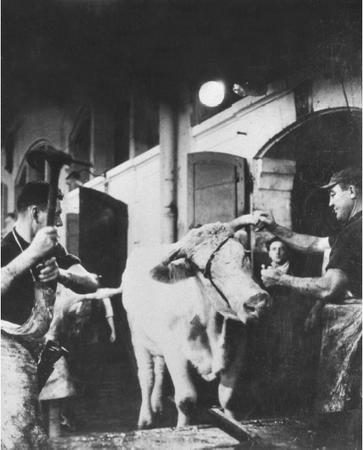Le Sang Des BÊtes - Film (Movie) Plot and Review
(Blood of the Beasts)
France, 1949
Director: Georges Franju
Production: Forces et Voix de France; black and white, 35mm; running time about 20 minutes; length: 600 meters. Released 1949. Filmed 1949 in a slaughterhouse outside Paris.
Producer: Paul Legros; screenplay: Georges Franju; commentary: Jean Painlevé; assistant directors: André Joseph and Julien Bonardier; photography: Marcel Fradetal assisted by Henri Champion; editor: Andre Joseph; sound engineer: Raymond Vachere; music: Joseph Kosma.
Cast: Nicole Ladmiral and Georges Hubert ( spoken parts ).
Publications
Script:
Franju, Georges, and Jean Painlevé, Le Sang des bêtes , in Avant-Scène du Cinéma (Paris), October 1964.
Books:
Lovell, Alan, Anarchist Cinema , London, 1962.
Armes, Roy, French Cinema Since 1946: The Personal Style , New York, 1966.
Durgnat, Raymond, Franju , Berkeley, 1968.
Vialle, Gabriel, Georges Franju , Paris, 1968.
Articles:
Goretta, Claude, "Aspects of French Documentaries," in Sight and Sound (London), Winter 1956–57.
Grenier, Cynthia, "Franju," in Sight and Sound (London), Spring 1957.
Godard, Jean-Luc, "Georges Franju," in Cahiers du Cinéma (Paris), December 1958.

"Franju Issue" of Image et Son (Paris), March 1966.
MacLochlainn, A., "The Films of Luis Buñuel and Georges Franju," in Film Journal (New York), Summer 1971.
Gow, Gordon, "Franju," in Films and Filming (London), August 1971.
Wood, Robin, "Terrible Buildings: The World of Georges Franju," in Film Comment (New York), November-December 1973.
"Le Sang des bêtes de Franju," in Avant-Scène du Cinéma (Paris), 15 October 1976.
Barbaro, Nick, in Cinema Texas Program Notes (Austin), 27 April 1978.
Boost, C., in Skoop (Amsterdam), August 1981.
* * *
The unique tone of Georges Franju's best work—which includes Le sang des bêtes —arises from its combination of hypersensitivity to pain (inseparable from an obsession with it) with an extraordinary poise. The peculiar distinction of his work goes inextricably with its very limited range: he is one of the cinema's authentic minor poets.
Although Hôtel des Invalides (Franju's masterpiece) is more complex, and although one would not wish to be without the other documentaries and many characteristic, privileged moments in the features, Le sang des bêtes already contains, in a form at once concentrated and comprehensive, all the major components of the Franju oeuvre . It is a film totally at odds with the Grierson school of documentary filmmaking (i.e., the task of documentary is to explain the world to us so that we can all understand each other): "understanding," to Franju, is the realization that civilization is constructed upon pain and horror and cannot be extricated from them.
The opening of the film—typically casual and disarming—establishes the location of the slaughterhouse. It is carefully set apart from the city that depends upon its activities, so that those who devour its products may be spared awareness of its existence, and of the physical realities of its interior. Separating it from Paris is a no-man's land where a young worker kisses his girlfriend goodbye, and where the debris of civilization—a heterogeneous, quasi-Surrealist assortment of junk objects divorced from their domestic contexts and deposited on the wasteland grass—is offered for sale, secondhand. The sequence (before we are introduced to any of the film's horrors) establishes with gentle irony and tenderness, a sense of the absurd and the arbitrary, of a world that never confronts the oddity of what it terms "reality."
The slaughterhouse itself is the first in the long succession of "terrible buildings" that provide Franju's work with one of its dominant recurrent motifs. It is a building at once thoroughly familiar, as everyone knows that slaughterhouses exist, but also hidden away because no one wants to confront or know about them. We are briefly shown the tools of slaughter. Then a white horse is led in through the gate. No one who has seen the film ever forgets the moment when a so-called humane killer is casually applied to its head and fired. From that moment on, the film spares us nothing of the details of slaughter, disembowellment, dismemberment. What is remarkable about the film is the way in which it scrupulously avoids, on the one hand, sadistic relish, and, on the other, the note of protest. Everything is shown calmly, dispassionately, generally at a distance. If a close-up is used, it is to clarify a detail of method or procedure. If the film converts some spectators to vegetarianism, this is purely incidental, a by-product of the audience's exposure to material they would prefer not to know about. The film is at once far more ambitious and far less presumptuous: it wishes to make us confront, with neither hysteria nor coercion, an aspect of the material reality on which our civilization is based.
—Robin Wood
Comment about this article, ask questions, or add new information about this topic: